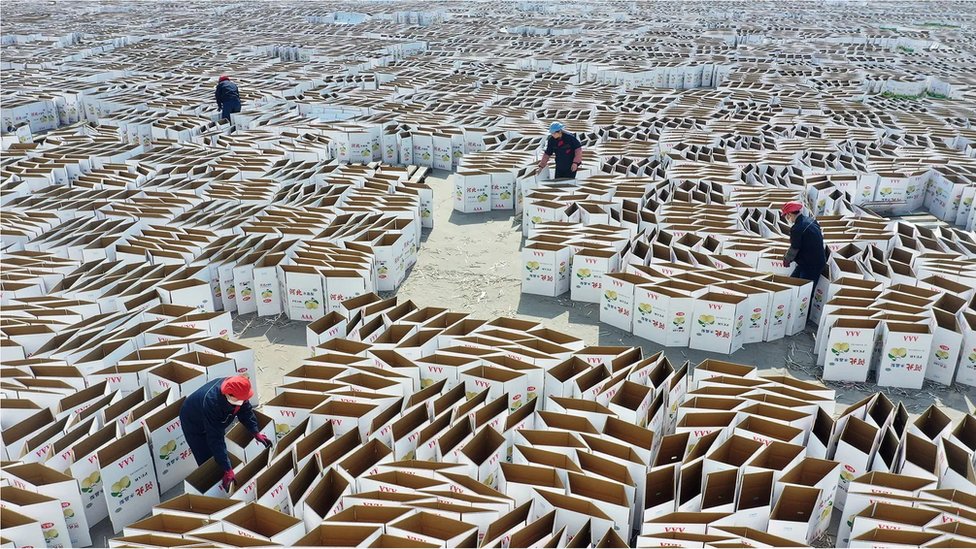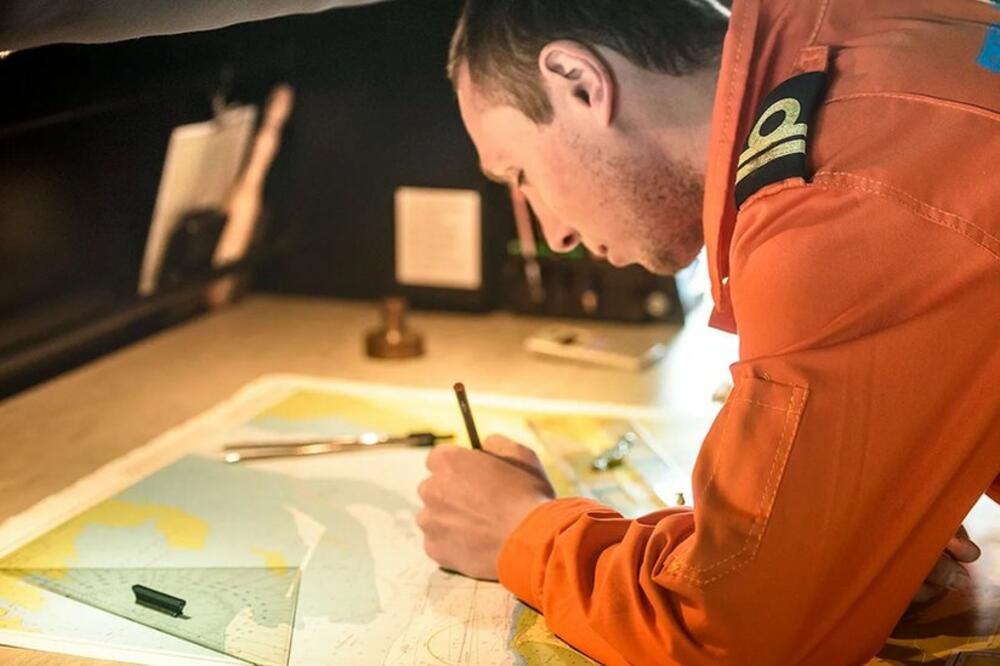When will they crumple it up and throw away the last page?
For four centuries, British hydrographers have been making paper charts of the world's seas and oceans.
Each shows in detail coasts, bays, straits or canals.
A document such as this is full of information, stating the depth of the sea at various locations, the position of rocks or places where ships may not drop anchor.
"It provides an incredibly rich picture to the mariner, enabling them to get the job done," says Stephen Bastable, product manager at the UK Hydrographic Office (UKHO).
- Jobs that artificial intelligence won't take from us (yet)
- Where to recycle in Serbia: Srdina's unique recycling map
- The art of saving trees: A device that removes ink from paper
- How long will we have to wait for a robot to start doing household chores?
In the past, nautical charts were so important that they were often depicted in portraits of great navigators, including James Cook.
Some of Cook's own maps were eventually published by the UKHO.
Today, nautical charts are carefully updated.
Every day, a UKHO employee makes corrections or improvements to some of the 3.500 charts they keep, such as adding locations with dangerous new wrecks and submarine cables or even changes to coastlines.
The weekly bulletin transmits modifications to cargo ships from around the world, and crews then have to pull out a pen and manually make corrections to any out-of-date paper copies.
And yet the last of these weekly newsletters is in sight.
UKHO is gradually preparing to discontinue the service of publishing paper charts and switch exclusively to digital versions, which will be accessed through the System for Electronic Chart Display on Ships.
Previously, the UKHO planned to do it in 2026, but the deadline was recently postponed.
"It became obvious that we had a problem, and if we rushed this too much, there was a very real risk that we would leave seafarers in the lurch," Bastable says.
"It's just something we're not prepared to do."
The switch to digital form will end the tradition of producing paper hydrographic charts in any form.
They were originally drawn by hand until printing presses and, later, computer software took over.
Last year, UKHO shut down its own paper ticket printing service.
The "paper" maps he makes today are actually digital documents that customers print themselves.
It turns out that quite a few ships still need paper versions.
Due to maritime regulations, ships must carry charts in some form and, despite the availability of electronic versions - which do not need to be manually updated every week - paper charts continue to be used as a backup, or in some cases, the only source of information. on board.
The Royal Yachting Association has also announced that, despite the UKHO's withdrawal of paper charts, it will continue to train people in the navigational techniques that use them.
Paper, it seems, still rules the waves.
But that's not all.
A two-thousand-year-old tradition, real paper made from trees is still considered essential to countless businesses and government systems around the world, despite the environmental impact its production has.
Computers, smartphones and tablets have been providing an alternative for decades.
Their illuminated screens can literally be written or erased with the push of a few buttons or the touch of a finger.
But the feel of the smooth surface of the paper in your hand or the way the freshly applied ink from your favorite fountain pen soaks into the fibrous surface - there is probably nothing quite like paper.
True, the use of what is called graph paper - that is, paper primarily used to convey printed information - is clearly in decline and has been for years.
The sale of paper tickets at UKHO is only 17 percent of what was sold just a decade ago, Bastable says.
Today, they make up less than 16 percent of all tickets sold by the agency at the moment.
However, paper is stubborn.
It can be extremely difficult for many organizations to go completely paperless.
It may also depend on habit, but in some cases there are strong reasons not to give up paper so easily - including aesthetics, functionality and even safety.
It is unusually difficult to give up paper.

"Do you see how this row of gold squares isn't even visible on the other side of the page? This is possible because of the thickness of the paper," says Erin Smith, a popular YouTuber who runs an office equipment channel.
She explains the benefits of good, quality paper in one of her videos on luxury new diary planners (bullet journals) - the practice of decorating and keeping a personal planner or diary in notebooks.
Planners are often made with heavy, colorful inks or motifs glued to its pages.
It's just one example of a special use of paper that has sprung up in a world full of digital alternatives.
Smith, who lives in Australia, told the BBC that there is an entire industry of quality office equipment manufacturers who market their products to those who want to use real paper, pencils and fountain pens, or even color their notebooks with watercolors to help track their habits, write down daily commitments or organized a month in advance.
In general, the best paper for diaries and notebooks has a weight of 160 grams per square meter (gsm), says Smith—about twice as thick as the paper used for a standard office printer.
"Now when I pick up a sheet of printer paper I feel a little uncomfortable," admits Smith.
But this fixation on physical stationery doesn't mean she rejects all things digital.
Smith is, after all, a YouTuber and even prefers reading e-books to paper books.
But journaling is an opportunity to do something creative away from a computer or smartphone screen—and for that, she wants the best materials possible.
Smith claims that in addition to being a pleasant, meditative experience, there is a concrete benefit to choosing paper for assignments such as this one.
"I've found that if I save something to my Google calendar, I'll only remember it if I look at it again," she says.
"But if I write it down by hand, I won't have to remind myself."
Watch the video:
Maybe there's something to her experience with paper as opposed to digital calendars.
A study published in 2021 showed that there is increased brain activity associated with recalling information once it has been written down by hand, as opposed to that entered into a smartphone or tablet.
The research was based on experiments with a small group of college students and recent graduates in Japan, though the authors did not investigate the broader or longer-term impact that extra brain activity might have on learning.
There's a big difference between information presented on paper and on screen, says Richard Harper, an expert in human-computer interaction at Lancaster University.
In 2002, Harper and his co-author Abigail Selen, a cognitive and computer scientist who now works for Microsoft, published a book The myth of the paperless office, which discusses why paper remains so vital in many business organizations.
"The mind is more receptive to detailed, complex, deep arguments that span several pages of paper," says Harper, noting that when you have something particularly layered and complex to say, it may be best to write it down by hand on paper.
In many cases, however, a persistent reliance on paper does not necessarily have to do with a true appreciation of its attributes.
Much like in the case of UKHO, many organizations try to go mostly or exclusively digital only to encounter major obstacles along the way.
The US government is getting ready to phase out paper, but it's taking much longer than first expected.
Last year, the National Archives and Records Administration revealed that a third of the vast federal government had not yet fully adopted electronic records, and the Administration was forced to extend the deadline for doing so by 18 months, to June 30, 2024.
Paper also plays a role in the more behind-the-scenes sectors of government.
In Great Britain, for example, the Government's Communications Headquarters keeps thousands of secret paper files on its staff in a basement vault, while the security service MI5 states on its website: "Paper files remain important to MI5."
Russia's Federal Security Service (FSO), in charge of Kremlin security, returned to using typewriters in 2013, ostensibly to prevent computer leaks.
Elsewhere, business logistics have long relied on paperwork to document the transit of goods, leading to massive paper trails and sometimes inefficient data processing.
Although that is starting to change, it is notoriously difficult to get rid of paper documents in this sector, say industry insiders.
Healthcare has also historically relied heavily on paper.
From prescriptions to hospital records, paper has persevered well into the 21st century.
To give just one example - the majority of care homes in south-east Scotland still use paper-based management systems, according to a study published last year.
Even as hospitals go digital, they may encounter difficulties storing historical paper records of patient care elsewhere.
Within the European Union, there are as many as 11 countries that still use paper for medical prescriptions instead of digital systems.
In the US, paper stubbornly remains in use in some parts of the health care system despite attempts to modernize it - it turns out that in 2021, 96 percent of hospitals and 78 percent of doctors used electronic health records.

Paper is still considered a backup medium whenever electronic systems fail, which of course they do regularly.
After a cyberattack on a small Alaskan community in 2018, municipal staff quickly switched to paper forms and typewriters when their computers went down.
Even Wikipedia, a giant online resource constantly updated and modified by people from all over the world, has an ironic contingency plan called the "Fatal Event Behavior Policy."
He jokingly suggests that during some potential future apocalyptic sequence of events such as "inevitable societal collapse" or "inevitable extinction event," Wikipedia's millions of editors will allegedly be tasked with printing out various pages of the online encyclopedia to preserve it for posterity. .
It's a humorous but often debated idea - because paper, when all is said and done, is considered reliable.
Perhaps that's why it's no surprise that in the episode "The Sickness" of Star Trek: Voyager, Captain Kathryn Janeway reminds a crew member that the Starfleet manual on personal relationships is three centimeters thick, a comment that unequivocally suggests that the manual, even in the year 2375, printed on paper.
Paper just seems to have a tendency to stay where it is.
Watch the video:
Oskar Lingqvist, global leader of paper and forest products at management consultancy McKinsey, recalls the stacks of hundred-page presentation materials he and his colleagues had to lug to client meetings.
Charts and data, neatly printed out and distributed to everyone at the conference table.
"It's a segment of paper usage that I would say has almost disappeared," he says.
But exemption from the last printed bill or form?
"It will be a long time before that," he says.
Graph paper finds niches, such as those mentioned above, in which it perseveres.
But the overall trend is an obvious decline, Lingqvist points out.
And that decline was accelerated by the eruption of the covid-19 pandemic.
"Even our most negative scenario was not negative enough compared to what actually happened in the market," he says, adding that the rate of decline is now slowing again and is likely to return to an annual global rate of decline of around 5 percent.
There are far fewer newspapers and magazines printed today than there were just a decade or two ago, for example, which is one big factor.
The frequency of working from home and corporate sustainability initiatives aimed at reducing paper consumption also play a large role.
But McKinsey's research also shows that other types of non-graphic paper, especially cardboard packaging, are simply booming.
The company's data indicates that the production of this type of paper in Europe almost doubled between 2000 and 2020.
In China, in the same period, it almost quadrupled.
The online shopping boom linked to the covid-19 lockdowns is one of the reasons for this.
Food packaging, e-commerce packaging and wrapping paper - all these types of paper are in increasing demand, says Alice Palmer, a Canadian freelance forest industry consultant.
Paper and cardboard are perceived as more sustainable, yet the distinction is not as clearly demarcated as many might think.

That many retail chains are moving away from plastic packaging anyway presents an industrial challenge for the paper industry because there are two main ways to produce paper, Palmer explains.
One involves using chemicals to turn wood into pulp - which usually yields quality paper full of strong fibers.
Another method uses heat and chopping to form the pulp, without the help of chemicals.
The paper you get from this type of pulp is a little less resistant.
However, it has served well for dailies and brochures over the years.
Although there is less demand for mechanical pulp in some regions today, some mills that make it cannot easily switch to chemical-made pulps, Palmer says.
"You have to rebuild the whole factory," she says.
"It's a multi-million or even billion-dollar investment."
Cardboard is in demand, but it requires strong fibers, which means that it is difficult for producers of old newspapers to dominate the market for packaging materials.
But they can provide a key component to corrugated board: "that ribbed layer in the middle," says Palmer.
Canadian paper company Catalyst Paper, with which Parker worked on a research project in 2015, is one example of a company that has made just that transition in some of its factories.
If you expand the term "paper" to include everything from luxury notebooks to Amazon packaging, it's clear that this material is more popular than ever.
But our dependence on paper as a consumable medium for packaging food or goods is problematic, says Sergio Bafoni, campaign coordinator at the Environmental Paper Network (EPN), a worldwide network of organizations that want to make the pulp and paper industry as sustainable as possible.
EPN says that three billion trees are cut down every year just to meet the need for packaging.
"It's crazy," says Bafoni.
"Only to throw it away at once—well, that's very stupid."
In the UK and US, approximately one third of paper and cardboard-based packaging is not recycled.
Bafoni says that cardboard makes a cheap packaging material only because its real cost—to ecosystems and our planet's ability to sequester carbon through tree photosynthesis—is "externalized."
It would be better to find packaging materials that can be reused and then keep them, he suggests.
Even plastic packaging would be better, he claims, if it could be used again and again, than cardboard packaging that is used only once.
Paper will probably never completely go out of style.
But considering that worldwide we have cut down an area of forest larger than the island of Borneo, at more than 800.000 square kilometers, in just 60 years, there are many who argue that we are too readily cutting down trees for the sake of a few sheets of paper.
Others would object and say that sometimes it's worth it: for the smell of a new book, for a handwritten letter to an old friend, or for a record that can survive even an apocalyptic future when the last computer and database no longer works.
Also watch this video:
Follow us on Facebook, Twitter i Viber. If you have a topic proposal for us, contact us at bbcnasrpskom@bbc.co.uk
Bonus video:




